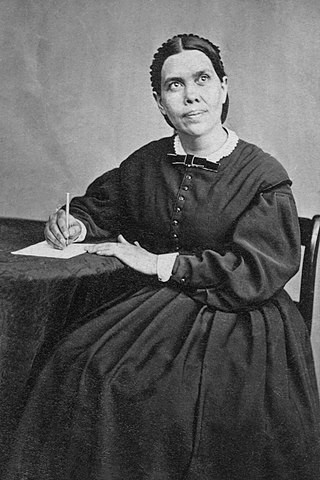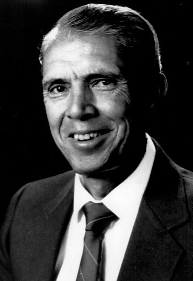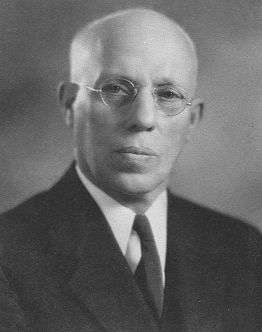
The Seventh-day Adventist Church (SDA) is an Adventist Protestant Christian denomination which is distinguished by its observance of Saturday, the seventh day of the week in the Christian (Gregorian) and the Hebrew calendar, as the Sabbath, its emphasis on the imminent Second Coming (advent) of Jesus Christ, and its annihilationist soteriology. The denomination grew out of the Millerite movement in the United States during the mid-19th century and it was formally established in 1863. Among its co-founders was Ellen G. White, whose extensive writings are still held in high regard by the church.

Ellen Gould White was an American author and co-founder of the Seventh-day Adventist Church. Along with other Adventist leaders such as Joseph Bates and her husband James White, she was instrumental within a small group of early Adventists who formed what became known as the Seventh-day Adventist Church. White is considered a leading figure in American vegetarian history. Smithsonian named her among the "100 Most Significant Americans of All Time".

Desmond Ford was an Australian theologian who studied evangelicalism.
Last Generation Theology (LGT) or "final generation" theology is a religious belief regarding moral perfection achieved by sanctified people in the last generation before the Second Coming of Jesus. Seventh-day Adventist hold that there will be an end-time remnant of believers who are faithful to God, which will be manifest shortly prior to the second coming of Jesus, as suggested by the 144,000 saints described in the Book of Revelation of the New Testament.
Herbert Edgar Douglass Jr. was a Seventh-day Adventist theologian. He was born in Springfield, Massachusetts, US, the oldest of five children to Herbert Edgar Douglass Sr (1904–1983) and Mildred Jennie Munson (1908–1988). He earned his Doctorate in Theology at Pacific School of Religion in 1964.
The investigative judgment, or pre-Advent Judgment, is a unique Seventh-day Adventist doctrine, which asserts that the divine judgment of professed Christians has been in progress since 1844. It is intimately related to the history of the Seventh-day Adventist Church and was described by one of the church's pioneers Ellen G. White as one of the pillars of Adventist belief. It is a major component of the broader Adventist understanding of the "heavenly sanctuary", and the two are sometimes spoken of interchangeably.
In Seventh-day Adventist theology, there will be an end time remnant of believers who are faithful to God. The remnant church is a visible, historical, organized body characterized by obedience to the commandments of God and the possession of a unique end-time gospel proclamation. Adventists have traditionally equated this "remnant church" with the Seventh-day Adventist denomination.

The Seventh-day Adventist Church holds a unique system of eschatological beliefs. Adventist eschatology, which is based on a historicist interpretation of prophecy, is characterised principally by the premillennial Second Coming of Christ. Traditionally, the church has taught that the Second Coming will be preceded by a global crisis with the Sabbath as a central issue. At Jesus' return, the righteous will be taken to heaven for one thousand years. After the millennium the unsaved cease to exist as they will be punished by annihilation while the saved will live on a recreated Earth for eternity.
The theology of the Seventh-day Adventist Church resembles that of Protestant Christianity, combining elements from Lutheran, Wesleyan-Arminian, and Anabaptist branches of Protestantism. Adventists believe in the infallibility of Scripture and teach that salvation comes from grace through faith in Jesus Christ. The 28 fundamental beliefs constitute the church's official doctrinal position.
Most Seventh-day Adventists believe church co-founder Ellen G. White (1827–1915) was inspired by God as a prophet, today understood as a manifestation of the New Testament "gift of prophecy," as described in the official beliefs of the church. Her works are officially considered to hold a secondary role to the Bible, but in practice there is wide variation among Adventists as to exactly how much authority should be attributed to her writings. With understanding she claimed was received in visions, White made administrative decisions and gave personal messages of encouragement or rebuke to church members. Seventh-day Adventists believe that only the Bible is sufficient for forming doctrines and beliefs, a position Ellen White supported by statements inclusive of, "the Bible, and the Bible alone, is our rule of faith".
The 1888 Minneapolis General Conference Session was a meeting of the General Conference of Seventh-day Adventists held in Minneapolis, Minnesota, in October 1888. It is regarded as a landmark event in the history of the Seventh-day Adventist Church. Key participants were Alonzo T. Jones and Ellet J. Waggoner, who presented a message on justification supported by Ellen G. White, but resisted by leaders such as G. I. Butler, Uriah Smith and others. The session discussed crucial theological issues such as the meaning of "righteousness by faith", the nature of the Godhead, the relationship between law and grace, and Justification and its relationship to Sanctification.

Seventh-day Adventists Answer Questions on Doctrine is a book published by the Seventh-day Adventist Church in 1957 to help explain Adventism to conservative Protestants and Evangelicals. The book generated greater acceptance of the Adventist church within the evangelical community, where it had previously been widely regarded as a cult. However, it also proved to be one of the most controversial publications in Adventist history and the release of the book brought prolonged alienation and separation within Adventism and evangelicalism.
Historic Adventism is an informal designation for conservative individuals and organizations affiliated with the Seventh-day Adventist Church who seek to preserve certain traditional beliefs and practices of the church. They feel that the church leadership has shifted or departed from key doctrinal "pillars" ever since the middle of the 20th century. Specifically, they point to the publication in 1957 of a book entitled Seventh-day Adventists Answer Questions on Doctrine; which they feel undermines historic Adventist theology in favor of theology more compatible with evangelicalism. Historic Adventism has been erroneously applied by some to any Adventists that adhere to the teachings of the church as reflected in the church's fundamental beliefs such as the Sabbath or the Spirit of Prophecy. They misapply those who hold to mainstream traditional Adventist beliefs as synonymous with Historic Adventist.

Milian Lauritz Andreasen, was a Seventh-day Adventist theologian, pastor and author.
George Raymond Knight is a leading Seventh-day Adventist historian, author, and educator. He is emeritus professor of church history at Andrews University. As of 2014 he is considered to be the best-selling and influential voice for the past three decades within the denomination.
In Seventh-day Adventist theology, the heavenly sanctuary teaching asserts that many aspects of the Hebrew tabernacle or sanctuary are representative of heavenly realities. In particular, Jesus is regarded as the High Priest who provides atonement for human sins by the sacrificial shedding of his blood at Calvary. The doctrine is based on Hebrews 4:14-15. As a whole, it is unique to Seventh-day Adventism, although other denominations share many of the typological identifications made by the epistle to the Hebrews, see Hebrews 8:2. One major aspect which is completely unique to Adventism is that the day of atonement is a type or foreshadowing of the investigative judgment. Technically, the "heavenly sanctuary" is an umbrella term which includes the investigative judgment, Christ's ministry in heaven before then, the understanding of Daniel 8:14, etc. However, it is often spoken of interchangeably with the investigative judgment.
Interpretations of the law in the Bible within the Seventh-day Adventist Church form a part of the broader debate regarding biblical law in Christianity. Adventists believe in a greater continuation of laws such as the law given to Moses in the present day than do most other Christians. In particular, they believe the 10 Commandments still apply to today, including the Sabbath in particular.

Edward E. Heppenstall was a leading Bible scholar and theologian of the Seventh-day Adventist Church. A 1985 questionnaire of North American Adventist lecturers revealed Heppenstall was the Adventist writer who had most influenced them.
The Seventh-day Adventist Church pioneers were members of Seventh-day Adventist Church, part of the group of Millerites, who came together after the Great Disappointment across the United States and formed the Seventh-day Adventist Church. In 1860, the pioneers of the fledgling movement settled on the name, Seventh-day Adventist, representative of the church's distinguishing beliefs. Three years later, on May 21, 1863, the General Conference of Seventh-day Adventists was formed and the movement became an official organization.
The Pillars of Adventism are landmark doctrines for Seventh-day Adventists. They are Bible doctrines that define who they are as a people of faith; doctrines that are "non-negotiables" in Adventist theology. The Seventh-day Adventist church teaches that these Pillars are needed to prepare the world for the second coming of Jesus Christ, and sees them as a central part of its own mission. Adventists teach that the Seventh-day Adventist Church doctrines were both a continuation of the reformation started in the 16th century and a movement of the end time rising from the Millerites, bringing God's final messages and warnings to the world.






